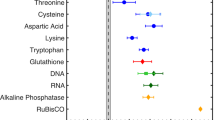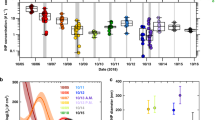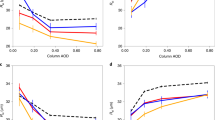Abstract
Atmospheric aerosol particles serve as nuclei for ice-crystal formation. As such, these particles are critical to the generation of cirrus clouds, which form from gas and liquid water1. Atmospheric aerosols also initiate ice formation in warmer, mixed-phase clouds, where ice crystals coexist with aqueous droplets1. Biogenic aerosol particles of terrestrial origin, including bacteria and pollen, can act as ice nuclei2. Whether biogenic particles of marine origin also act as ice nuclei has remained uncertain3,4,5. We exposed the cosmopolitan planktonic diatom species Thalassiosira pseudonana to water vapour and supercooled aqueous sodium chloride under typical tropospheric conditions conducive to cirrus-cloud formation. Ice nucleation was determined using a controlled vapour cooling-stage microscope system. Under all conditions, diatoms initiated ice formation. The presence of diatoms in water increased the temperature for ice formation up to 13 K, and in aqueous sodium chloride, ice formed at temperatures up to 30 K higher than when diatoms were not present. In addition, diatoms initiated ice formation from water vapour at relative humidities as low as 65%. The rate of ice nucleation was rapid and independent of surface area. We suggest that marine biogenic particles such as diatoms help explain high values and seasonal variations6,7 in ice-nuclei concentrations8,9,10 in subpolar regions.
This is a preview of subscription content, access via your institution
Access options
Subscribe to this journal
Receive 12 print issues and online access
$259.00 per year
only $21.58 per issue
Buy this article
- Purchase on Springer Link
- Instant access to full article PDF
Prices may be subject to local taxes which are calculated during checkout


Similar content being viewed by others
References
Baker, M. B. & Peter, T. Small-scale cloud processes and climate. Nature 451, 299–300 (2008).
Ariya, P. A. et al. Physical and chemical characterization of bioaerosols—Implications for nucleation processes. Int. Rev. Phys. Chem. 28, 1–32 (2009).
Junge, K & Swanson, B. D. High-resolution ice nucleation spectra of sea-ice bacteria: Implications for cloud formation and life in frozen environments. Biogeosciences 5, 865–873 (2008).
Fall, R & Schnell, R. C. Association of an ice-nucleating pseudomonad with cultures of the marine dinoflagellate, Heterocapsa niei. J. Mar. Res. 43, 257–265 (1985).
Rosinski, J., Haagenson, P. L., Nagamoto, C. T. & Parungo, F. Ice forming nuclei of maritime origin. J. Aerosol Sci. 17, 23–46 (1986).
Bigg, E. K. Ice forming nuclei in the high Arctic. Tellus B 48, 223–233 (1996).
Prenni, A. J. et al. Ice nuclei characteristics from M-PACE and their relation to ice formation in clouds. Tellus B 61, 436–448 (2009).
Bigg, E. K. Ice nucleus concentrations in remote areas. J. Atmos. Sci. 30, 1153–1157 (1973).
Schnell, R. C. Ice nuclei produced by laboratory cultured marine phytoplankton. Geophys. Res. Lett. 2, 500–502 (1975).
Schnell, R. C. & Vali, G. Biogenic ice nuclei: Part I. Terrestrial and marine sources. J. Atmos. Sci. 33, 1554–1564 (1976).
Chen, T., Rossow, W. B. & Zhang, Y. C. Radiative effects of cloud-type variations. J. Clim. 13, 264–286 (2000).
Vavrus, S. The impact of cloud feedbacks on Arctic climate under greenhouse forcing. J. Clim. 17, 603–615 (2004).
Knopf, D. A., Wang, B., Laskin, A., Moffet, R. C. & Gilles, M. K. Heterogeneous nucleation of ice on anthropogenic organic particles collected in Mexico City. Geophys. Res. Lett. 37, L11803 (2010).
Alvain, S., Moulin, C., Dandonneau, Y. & Loisel, H. Seasonal distribution and succession of dominant phytoplankton groups in the global ocean: A satellite view. Glob. Biogeochem. Cycles 22, GB3001 (2008).
Cipriano, R. J. & Blanchard, D. C. Bubble and aerosol spectra produced by a laboratory breaking wave. J. Geophys. Res. 86, 8085–8092 (1981).
Brown, R. M., Larson, D. A. & Bold, H. C. Airborne algae: Their abundance and heterogeneity. Science 143, 583–585 (1964).
Harper, M. A. The Diatoms: Applications for the Environmental and Earth Sciences Ch. 22 (Cambridge Univ. Press, 1999).
Knopf, D. A. & Lopez, M. D. Homogeneous ice freezing temperatures and ice nucleation rates of aqueous ammonium sulfate and aqueous levoglucosan particles for relevant atmospheric conditions. Phys. Chem. Chem. Phys. 11, 8056–8068 (2009).
Koop, T., Luo, B. P., Tsias, A. & Peter, T. Water activity as the determinant for homogeneous ice nucleation in aqueous solutions. Nature 406, 611–614 (2000).
Knopf, D. A. & Koop, T. Heterogeneous nucleation of ice on surrogates of mineral dust. J. Geophys. Res. 111, D12201 (2006).
Kärcher, B. & Lohmann, U. A parameterization of cirrus cloud formation: Heterogeneous freezing. J. Geophys. Res. 108, D144402 (2003).
Corti, T. & Peter, T. A simple model for cloud radiative forcing. Atmos. Chem. Phys. 9, 5751–5758 (2009).
Abbatt, J. P. D. et al. Solid ammonium sulfate aerosols as ice nuclei: A pathway for cirrus cloud formation. Science 313, 1770–1773 (2006).
Gavish, M., Popovitzbiro, R., Lahav, M. & Leiserowitz, L. Ice nucleation by alcohols arranged in monolayers at the surface of water drops. Science 250, 973–975 (1990).
Boyce, D. G., Lewis, M. R. & Worm, B. Global phytoplankton decline over the past century. Nature 466, 591–596 (2010).
Ström, J. et al. Cirrus cloud occurrence as function of ambient relative humidity: A comparison of observations obtained during the INCA experiment. Atmos. Chem. Phys. 3, 1807–1816 (2003).
Heymsfield, A. J. & Miloshevich, L. M. Relative humidity and temperature influences on cirrus formation and evolution: Observations from wave clouds and FIRE II. J. Atmos. Sci. 52, 4302–4326 (1995).
Falkowski, P. G. & Oliver, M. J. Diatoms in a future ocean—stirring it up: Reply from Falkowski and Oliver. Nat. Rev. Microbiol. 6, 407 (2008).
Peters, F. Diatoms in a future ocean—stirring it up. Nat. Rev. Microbiol. 6, 407 (2008).
Fisher, N. S. & Wente, M. The release of trace elements by dying marine phytoplankton. Deep-Sea Res. I 40, 671–694 (1993).
Acknowledgements
We thank S. Palma and N. Fisher for providing diatom cultures and J. Radway for assistance in diatom preparation. This work was supported by the NOAA Climate Program Office, Atmospheric Composition and Climate Program.
Author information
Authors and Affiliations
Contributions
D.A.K. initiated and supervised project, designed and developed ice nucleation experiments, and led manuscript preparation. P.A.A. developed diatom particle preparation, conducted ice-nucleation experiments, and contributed to writing the manuscript. B.W. conducted ice-nucleation experiments, and contributed to writing the manuscript. J.Y.A. supervised preparation of phytoplankton cultures and contributed to the manuscript writing.
Corresponding author
Ethics declarations
Competing interests
The authors declare no competing financial interests.
Rights and permissions
About this article
Cite this article
Knopf, D., Alpert, P., Wang, B. et al. Stimulation of ice nucleation by marine diatoms. Nature Geosci 4, 88–90 (2011). https://doi.org/10.1038/ngeo1037
Received:
Accepted:
Published:
Issue Date:
DOI: https://doi.org/10.1038/ngeo1037
This article is cited by
-
Ice nucleation catalyzed by the photosynthesis enzyme RuBisCO and other abundant biomolecules
Communications Earth & Environment (2023)
-
Boreal pollen contain ice-nucleating as well as ice-binding ‘antifreeze’ polysaccharides
Scientific Reports (2017)
-
Bioaerosol generation by raindrops on soil
Nature Communications (2017)
-
Polytrichum commune spores nucleate ice and associated microorganisms increase the temperature of ice nucleation activity onset
Aerobiologia (2016)
-
A marine biogenic source of atmospheric ice-nucleating particles
Nature (2015)



